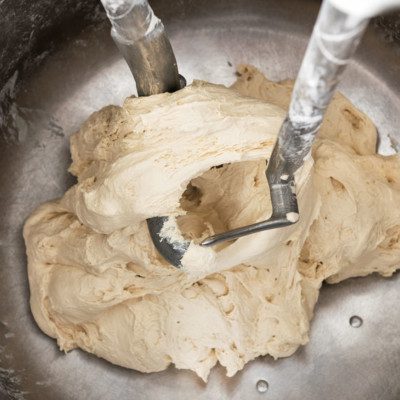Dough mixers
This type is designed to promote intense motion where the dough gets pulled, sheared, compressed, kneaded, and folded by the action of rotor, arm or blades against vessel walls, pins or stators.
Dough mixers markedly differ from those used in other process and food applications (e.g. liquid agitated tanks), they mostly handle Newtonian liquid products of minimal variation in composition between production runs.
They are capable of handling extremely viscous materials (up to 1×106 centipoise) which exhibit non-Newtonian fluid behaviour. Due to the presence of gluten-forming proteins, these doughs typically show a viscoelastic behavior which has a fluid-like (viscous) and solid-like (elastic) component.1,2
Because of the complex rheology of yeasted doughs, dough mixers are designed empirically rather than by following traditional engineering principles of process design. Instead, information such as lab experimentation, trial and error and empirical correlations are relied on.
Batter mixers
Batter mixers are designed to process fluid batters for the production of layer cakes, muffins, pound cakes and other sweet baked goods. This type of mixers is not intended to be as strong as dough mixers since their function is to aerate viscous and pumpable batters to a pre-set specific gravity.
Application
Types of mixers include:
- Planetary (vertical)
- Horizontal trough
- Spiral
- Continuous
- High-speed (high revolutions per minute)
- Screw conveyor or extruder
Considerations for mixer design:
- Motor size (power required) Should match mixing intensity, viscosity and strength of dough
- Lubrication, repair and replacement of moving parts (e.g. gears, chains, transmission system)
- Mixing conditions (e.g. rpm)
- Electrical energy consumption per mixing cycle (KW)
- Energy efficiency (electrical and mechanical)
- Size and geometry of mixing arm (e.g. Sigma-, Z-shaped blades)
- Hygienic design requirements (e.g. materials of construction, self-draining tank, smooth surface finish, welding, dis-mountable joints, absence of crevices, pockets and dead areas)
- Total mixing tank volume
- Piping and pumping requirements for integrated ingredient handling systems
- Inlet ports for dry and liquid ingredients metering and dosing
- Discharge mechanism (i.e. dough unloading systems)
- Dough temperature control system (cooling jacket)
- Coolant physical and thermal properties
- Dough load (Lb or Kg) required to keep up with divider’s throughput
- Mixer capacity (i.e. optimum dough load) in Lb or Kg
- Minimum and maximum dough sizes
- Mode of operation, batch or continuous
Adequate mixers must be designed to always keep the divider fully operational and utilized. Mixer installed capacity (pieces per min) and dough load to process determine the cycle time. Mixing time should be as close to that of the divider to eliminate waiting and idle times where dough might stand for too long and becomes gassy.
The following formula can be used to calculate the number of pieces of dough that a mixer can deliver:
Engineering components to integrate in mixer design include:
- Electrical components (e.g. motor)
- Mechanical components (e.g. transmission belts or chains, gears)
- Pipeline and pumps for liquid ingredients dosing
- Thermal components (e.g. cooling system)
- Electronics and automation systems
- Instrumentation and control devices
- General construction components (e.g. equipment walls, supports, safety screen)
References
- Steffe, J.F. “Introduction to Rheology.” Rheological Methods in Food Process Engineering, 2nd edition, Freeman Press, 1996, pp. 11–93.
- Todd, D.B. “Mixing of Highly Viscous Fluids, Polymers, and Pastes.” Handbook of Industrial Mixing: Science and Practice, John Wiley & Sons, Inc., 2004, pp. 987–1023.

